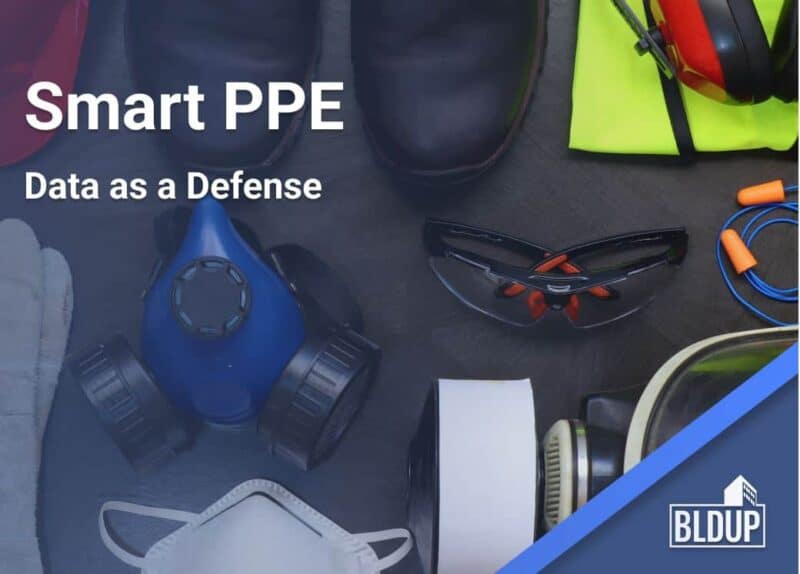Smart PPE for the construction industry refers to any wearable equipment that can deliver real-time safety data to both workers on the job site and managers remotely. These devices can track movements, monitor body temperature, issue alerts, and even record audio or video. The goal; improve workplace safety and achieve operational efficiencies. While still not widely adopted across the industry, Fortune Business Insights expects the global smart PPE technology market size to hit $9.05 billion by 2028 up from $3.13 billion in 2021.
While there are certainly many positives to utilizing these new technologies, questions remain, primarily centered around cost and worker data collection, and privacy. BLDUP spoke with Steve Matin, an Assistant Project Manager with leading electrical subcontractor, JM Electrical to discuss how their firm brings new technologies to the table and his thoughts on how to handle emerging Smart PPE technology on the job site.
BLDUP: In general, how does JM handle the evaluation and adoption of new technology within their firm?
Steven Matin: We strive to implement the most effective technology for any given purpose. When evaluating a new system, functionality and accessibility are often the first things we consider; novelty is a secondary concern. I come from an engineering background and generally skepticize ‘cutting-edge’ or ‘groundbreaking’ inventions. There are reasons a system remains unchanged for a long time. However, sometimes the best solution is a new tool or technology. Our decisions are always based on each project’s needs assessment.
BLDUP: Does JM Electrical currently utilize smart PPE on any job sites? If so, what type and what has the experience been with this new technology?
Steve Matin: On one of our projects at 225 Wyman Street, we are using smart PPE, the Spot-r clip. This is required of all the subcontractors and it’s basically a wearable transmitter that identifies the approximate zone-based location of each user and allows for hazard alert/distress signaling. There is no GPS or cell phone monitoring involved, and it cannot be traced outside of the network. I am not personally familiar with the technology and can’t rate its effectiveness, but it’s worth exploring.
BLDUP: Smart PPE is often more expensive than standard PPE, do you feel the added data/safety can justify the additional costs.
Steve Matin: That would depend on a number of considerations:
Our main goal in utilizing smart PPE would be mitigating the potential for serious injury. I don’t think a smart helmet that sounds an alarm when the wearer wanders into a hazardous location is superior to a traditional helmet. Our industry must prevent dangerous situations altogether, and not scramble to address them in the moment. If the user finds themselves in hazardous area, the risk of injury already exists regardless of which helmet they are wearing.
Now something like a smart lockout/tagout device could warrant the additional cost. LOTO is one of OSHA’s most frequently violated safety protocols and doing so can often cause harm to more than one worker. A lockout prevents a critical piece of equipment from being powered on prematurely. Therefore, any additional layers of protection can and should be justified. The fact is, these devices aren’t very costly in the first place.
Ergonomics are also extremely important to consider here. If a smart device is harder to use than its conventional counterpart, workers could be more reluctant to use it. A scenario like this could lead to additional cost without any of the key benefits.
BLDUP: How are (or how do you expect) workers in the field reacting to having their data tracked via smart PPE? How do you handle privacy concerns?
Steve Matin: One of our core values as a company is rooted in relationships: There is a prominent ‘people aspect’ associated with our line of work. We don’t want to discourage a worker from socializing or conversing due to overt concerns over productivity – because these interactions help create lasting connections with our customers and fellow employees.
If we were to implement some sort of tracking system for our field workforce, it would likely involve non-GPS devices. I don’t think it’s necessary to scrutinize the singular movements of every employee. Our electricians are skilled, hard-working, and know where they need to be on a daily basis.
BLDUP: How do you expect to handle that potential influx of data that could be collected through these various smart PPE devices when more begin to be used in the field.
Steve Matin: It could get quite complicated. There would be additional cost and logistical issues beyond the use of the PPE devices. Our practices would depend on how widespread the technology becomes in the next few years. If most construction companies start implementing smart PPE in their workplace, then I’m sure there will be general third-party solutions available. All Spot-r devices, for example, come with their own IoT platform that can be employed by an on-site supervisor. If smart PPE remains obscure, then companies might have to collect, store, and analyze the data internally – a time-consuming process that would be much more difficult to undertake.
